Towards Optimisation of Microalgae Cultivation through Monitoring and Control in Membrane Photobioreactor Systems
Abstract
:1. Introduction
- Land requirements: current requirements for microalgae cultivation (up to 10 m2 per equivalent person) impede industrial scalability, demanding a reduction to approximately 1 m2 per equivalent person for viability [13].
2. Materials and Methods
2.1. MPBR Pilot Plant
2.1.1. Instrumentation and Automation
2.1.2. Microalgae Substrate and Inoculum
2.1.3. Pilot Plant Operation
2.2. Solids Retention Time Control
2.2.1. Monitoring Variables and SRT Control Indicators
2.2.2. SRT Controller
2.3. New Parameter Based on DO25
2.4. Sampling and Methods
2.5. Filtration Performance Assessment
2.6. Energy and GHG Emissions Estimation
3. Results and Discussion
3.1. SRT Controller Performance
3.2. Evaluation of MPBR Performance through 25 °C-Standardised DO-Based Parameter
3.3. Filtration Performance
3.4. GHG Emissions Estimation
4. Conclusions
Author Contributions
Funding
Data Availability Statement
Conflicts of Interest
References
- Oviedo, J.A.; Muñoz, R.; Donoso-Bravo, A.; Bernard, O.; Casagli, F.; Jeison, D. A half-century of research on microalgae-bacteria for wastewater treatment. Algal Res. 2022, 67, 102828. [Google Scholar] [CrossRef]
- Dasan, Y.K.; Lam, M.K.; Chai, Y.H.; Lim, J.W.; Ho, Y.C.; Tan, I.S.; Lau, S.Y.; Show, P.L.; Lee, K.T. Unlocking the potential of microalgae bio-factories for carbon dioxide mitigation: A comprehensive exploration of recent advances, key challenges, and energy-economic insights. Bioresour. Technol. 2023, 380, 129094. [Google Scholar] [CrossRef]
- Sadvakasova, A.K.; Kossalbayev, B.D.; Bauenova, M.O.; Balouch, H.; Leong, Y.K.; Zayadan, B.K.; Huang, Z.; Alharby, H.F.; Tomo, T.; Chang, J.-S.; et al. Microalgae as a key tool in achieving carbon neutrality for bioproduct production. Algal Res. 2023, 72, 103096. [Google Scholar] [CrossRef]
- European Commission. Proposal for a Directive of the European Parliament and of the Council Concerning urban Wastewater Treatment; European Commission: Brussels, Belgium, 2022; Available online: https://environment.ec.europa.eu/publications/proposal-revised-urban-wastewater-treatment-directive_en (accessed on 23 November 2023).
- Amaro, H.M.; Salgado, E.M.; Nunes, O.C.; Pires, J.C.M.; Esteves, A.F. Microalgae systems-environmental agents for wastewater treatment and further potential biomass valorization. J. Environ. Manag. 2023, 337, 117678. [Google Scholar] [CrossRef] [PubMed]
- Al-Jabri, H.; Das, P.; Khan, S.; Thaher, M.; AbdulQuadir, M. Treatment of Wastewaters by Microalgae and the Potential Applications of the Produced Biomass—A Review. Water 2021, 13, 27. [Google Scholar] [CrossRef]
- Olguín, E.J.; Sánchez-Galván, G.; Arias-Olguín, I.I.; Melo, F.J.; González-Portela, R.E.; Cruz, L.; De Philippis, R.; Adessi, A. Microalgae-Based Biorefineries: Challenges and Future Trends to Produce Carbohydrate Enriched Biomass, High-Added Value Products and Bioactive Compounds. Biology 2022, 11, 1146. [Google Scholar] [CrossRef] [PubMed]
- Chen, Z.H.; Shao, S.S.; He, Y.J.; Luo, Q.Q.; Zheng, M.M.; Zheng, M.Q.; Chen, B.L.; Wang, M.Z. Nutrients removal from piggery wastewater coupled to lipid production by a newly isolated self-flocculating microalga Desmodesmus sp. PW1. Bioresour. Technol. 2020, 302, 122806. [Google Scholar] [CrossRef]
- Li, L.; Gao, K.; Yang, M.; Zheng, Q.; Zhang, M.; Deng, X. Challenges and potential solutions of microalgae-based systems for wastewater treatment and resource recovery. Front. Bioeng. Biotechnol. 2023, 11, 1210228. [Google Scholar] [CrossRef]
- De-Luca, R.; Trabuio, M.; Barolo, M.; Bezzo, F. Microalgae growth optimization in open ponds with uncertain weather data. Comp. Chem. Eng. 2018, 117, 410–419. [Google Scholar] [CrossRef]
- Day, J.G.; Gong, Y.; Hu, Q. Microzooplanktonic grazers—A potentially devastating threat to the commercial success of microalgae mass culture. Algal Res. 2017, 27, 356–365. [Google Scholar] [CrossRef]
- Morais, E.G.; Cristofoli, N.L.; Maia, I.B.; Magina, T.; Cerqueira, P.R.; Teixeira, M.R.; Varela, J.; Barreira, L.; Gouveia, L. Microalgae Systems for Wastewater Treatment: Technological Trends and Challenges towards Waste Recovery. Energies 2021, 14, 8112. [Google Scholar] [CrossRef]
- Acién-Fernández, F.G.; Gómez-Serrano, C.; Fernández-Sevilla, J.M. Recovery of Nutrients From Wastewaters Using Microalgae. Front. Sustain. Food Syst. 2018, 2, 59. [Google Scholar] [CrossRef]
- Rossi, S.; Mantovani, M.; Marazzi, F.; Bellucci, M.; Casagli, F.; Mezzanotte, V.; Ficara, E. Microalgae cultivation on digestate: Process efficiency and economics. Chem. Eng. J. 2023, 460, 141753. [Google Scholar] [CrossRef]
- Xu, X.; Gu, X.; Wang, Z.; Shatner, W.; Wang, Z. Progress, challenges and solutions of research on photosynthetic carbon sequestration efficiency of microalgae. Renew. Sustain. Energy Rev. 2019, 110, 65–82. [Google Scholar] [CrossRef]
- Morillas-España, A.; Lafarga, T.; Acién-Fernández, F.G.; Gómez-Serrano, C.; González-López, C.V. Annual production of microalgae in wastewater using pilot-scale thin-layer cascade photobioreactors. J. Appl. Phycol. 2021, 33, 3861–3871. [Google Scholar] [CrossRef]
- Ding, M.; Wang, C.; Bae, S.W.; Ng, H.Y. Enhanced nutrient removal and bioenergy production in microalgae photobioreactor following anaerobic membrane bioreactor for decarbonized wastewater treatment. Bioresour. Technol. 2022, 364, 128120. [Google Scholar] [CrossRef] [PubMed]
- Arbib, Z.; de Godos, I.; Ruiz, J.; Perales, J.A. Optimization of pilot high rate algal ponds for simultaneous nutrient removal and lipids production. Sci. Total Environ. 2017, 589, 66–72. [Google Scholar] [CrossRef] [PubMed]
- Jerney, J.; Spilling, K. Large Scale Cultivation of Microalgae: Open and Closed Systems. In Biofuels from Algae, 1st ed.; Spilling, K., Ed.; Humana: New York, NY, USA, 2018; pp. 1–8. [Google Scholar] [CrossRef]
- Luo, Y.; Le-Clech, P.; Henderson, R.K. Assessment of membrane photobioreactor (MPBR) performance parameters and operating conditions. Water Res. 2018, 138, 169–180. [Google Scholar] [CrossRef]
- Goh, P.S.; Ahmad, N.A.; Lim, J.W.; Liang, Y.Y.; Kang, H.S.; Ismail, A.F.; Arthanareeswaran, G. Microalgae-Enabled Wastewater Remediation and Nutrient Recovery through Membrane Photobioreactors: Recent Achievements and Future Perspective. Membranes 2022, 12, 1094. [Google Scholar] [CrossRef]
- Díaz, V.; Antiñolo, L.; Poyatos Capilla, J.M.; Almécija, M.C.; Muñío, M.d.M.; Martín-Pascual, J. Nutrient Removal and Membrane Performance of an Algae Membrane Photobioreactor in Urban Wastewater Regeneration. Membranes 2022, 12, 982. [Google Scholar] [CrossRef]
- Viruela, A.; Robles, A.; Durán, F.; Ruano, M.V.; Barat, R.; Ferrer, J.; Seco, A. Performance of an outdoor membrane photobioreactor for resource recovery from anaerobically treated sewage. J. Clean. Prod. 2018, 178, 665–674. [Google Scholar] [CrossRef]
- De Francisci, D.; Su, Y.; Lital, A.; Angelidaki, I. Evaluation of microalgae production coupled with wastewater treatment. Environ. Technol. 2018, 39, 581–592. [Google Scholar] [CrossRef] [PubMed]
- Vaz, S.A.; Badenes, S.M.; Pinheiro, H.M.; Martins, R.C. Recent reports on domestic wastewater treatment using microalgae cultivation: Towards a circular economy. Environ. Technol. Innov. 2023, 30, 103107. [Google Scholar] [CrossRef]
- Acién-Fernandez, F.G.; Reis, A.; Wijffels, R.H.; Barbosa, M.; Verdelho, V.; Llamas, B. The role of microalgae in the bioeconomy. New Biotechnol. 2021, 61, 99–107. [Google Scholar] [CrossRef] [PubMed]
- Oruganti, R.K.; Biji, A.P.; Lanuyanger, T.; Show, P.L.; Sriariyanun, M.; Upadhyayula, V.K.K.; Gadhamshetty, V.; Bhattacharyya, D. Artificial intelligence and machine learning tools for high-performance microalgae wastewater treatment and algal biorefinery: A critical review. Sci. Total Environ. 2023, 876, 162797. [Google Scholar] [CrossRef]
- Mora-Sánchez, J.F.; González-Camejo, J.; Seco, A.; Ruano, M.V. Advanced HRT-Controller Aimed at Optimising Nitrogen Recovery by Microalgae: Application in an Outdoor Flat-Panel Membrane Photobioreactor. ChemEngineering 2022, 6, 24. [Google Scholar] [CrossRef]
- Ruiz, J.; Álvarez-Díaz, P.D.; Arbib, Z.; Garrido-Pérez, C.; Barragán, J.; Perales, J.A. Performance of a flat panel reactor in the continuous culture of microalgae in urban wastewater: Prediction from a batch experiment. Bioresour. Technol. 2013, 127, 456–463. [Google Scholar] [CrossRef]
- Morillas-España, A.; Lafarga, T.; Gomez-Serrano, C.; Acién-Fernández, F.G.; Gonzalez-Lopez, C.V. Year-long production of Scenedesmus almeriensis in pilot-scale raceway and thin-layer cascade photobioreactors. Algal Res. 2020, 51, 102069. [Google Scholar] [CrossRef]
- Tan, X.-B.; Zhang, Y.-L.; Yang, L.-B.; Chu, H.-Q.; Guo, J. Outdoor cultures of Chlorella pyrenoidosa in the effluent of anaerobically digested activated sludge: The effects of pH and free ammonia. Bioresour. Technol. 2016, 200, 606–615. [Google Scholar] [CrossRef]
- Gonzalez-Camejo, J.; Montero, P.; Aparicio, S.; Ruano, M.V.; Borras, L.; Seco, A.; Barat, R. Nitrite inhibition of microalgae induced by the competition between microalgae and nitrifying bacteria. Water Res. 2020, 172, 115499. [Google Scholar] [CrossRef]
- Zhang, M.; Yao, L.; Maleki, E.; Liao, B.-Q.; Lin, H. Membrane technologies for microalgae cultivation and dewatering: Recent progress and challenges. Algal Res. 2019, 44, 101686. [Google Scholar] [CrossRef]
- Xu, M.; Li, P.; Tang, T.; Hu, Z. Roles of SRT and HRT of an algal membrane bioreactor system with a tanks-in-series configuration for secondary wastewater effluent polishing. Ecol. Eng. 2015, 85, 257–264. [Google Scholar] [CrossRef]
- Lau, A.K.S.; Bilad, M.R.; Osman, N.B.; Marbelia, L.; Putra, Z.A.; Nordin, N.A.H.M.; Wirzal, M.D.H.; Jaafar, J.; Khan, A.L. Sequencing batch membrane photobioreactor for simultaneous cultivation of aquaculture feed and polishing of real secondary effluent. J. Water Process Eng. 2019, 29, 100779. [Google Scholar] [CrossRef]
- Zhao, Z.; Muylaert, K.; Vankelecom, I.F.J. Applying membrane technology in microalgae industry: A comprehensive review. Renew. Sustain. Energy Rev. 2023, 172, 113041. [Google Scholar] [CrossRef]
- Zou, H.; Rutta, N.C.; Chen, S.; Zhang, M.; Lin, H.; Liao, B. Membrane Photobioreactor Applied for Municipal Wastewater Treatment at a High Solids Retention Time: Effects of Microalgae Decay on Treatment Performance and Biomass Properties. Membranes 2022, 12, 564. [Google Scholar] [CrossRef] [PubMed]
- Luo, Y.; Le-Clech, P.; Henderson, R.K. Simultaneous microalgae cultivation and wastewater treatment in submerged membrane photobioreactors: A review. Algal Res. 2017, 24, 425–437. [Google Scholar] [CrossRef]
- Mao, Y.; Xiong, R.; Gao, X.; Jiang, L.; Peng, Y.; Xue, Y. Analysis of the Status and Improvement of Microalgae Phosphorus Removal from Municipal Wastewater. Processes 2021, 9, 1486. [Google Scholar] [CrossRef]
- Morillas-Espana, A.; Lafarga, T.; Sanchez-Zurano, A.; Acien-Fernandez, F.G.; Rodriguez-Miranda, E.; Gomez-Serrano, C.; Gonzalez-Lopez, C.V. Year-long evaluation of microalgae production in wastewater using pilot-scale raceway photobioreactors: Assessment of biomass productivity and nutrient recovery capacity. Algal Res. 2021, 60, 102500. [Google Scholar] [CrossRef]
- González-Camejo, J.; Robles, A.; Seco, A.; Ferrer, J.; Ruano, M.V. On-line monitoring of photosyntethic activity based on pH data to assess microalgae cultivation. J. Environ. Manag. 2020, 276, 111343. [Google Scholar] [CrossRef]
- Seco, A.; Aparicio, S.; González-Camejo, J.; Jiménez-Benítez, A.; Mateo, O.; Mora-Sánchez, J.F.; Noriega-Hevia, G.; Sanchis-Perucho, P.; Serna-García, R.; Zamorano-López, N.; et al. Resource recovery from sulphate-rich sewage through an innovative anaerobic-based water resource recovery facility (WRRF). Water Sci. Technol. 2018, 78, 1925–1936. [Google Scholar] [CrossRef]
- González-Camejo, J.; Aparicio, S.; Jiménez-Benítez, A.; Pachés, M.; Ruano, M.V.; Borrás, L.; Barat, R.; Seco, A. Improving membrane photobioreactor performance by reducing light path: Operating conditions and key performance indicators. Water Res. 2020, 172, 115518. [Google Scholar] [CrossRef] [PubMed]
- Krustok, I.; Odlare, M.; Truu, J.; Nehrenheim, E. Inhibition of nitrification in municipal wastewater-treating photobioreactors: Effect on algal growth and nutrient uptake. Bioresour. Technol. 2016, 202, 238–243. [Google Scholar] [CrossRef] [PubMed]
- Sánchez-Zurano, A.; Ciardi, M.; Lafarga, T.; Fernández-Sevilla, J.M.; Bermejo, R.; Molina-Grima, E. Role of Microalgae in the Recovery of Nutrients from Pig Manure. Processes 2021, 9, 203. [Google Scholar] [CrossRef]
- Salgado, E.M.; Esteves, A.F.; Gonçalves, A.L.; Pires, J.C.M. Microalgae cultures for the remediation of wastewaters with different nitrogen to phosphorus ratios: Process modelling using artificial neural networks. Environ. Res. 2023, 231 Pt 1, 116076. [Google Scholar] [CrossRef] [PubMed]
- Larsen, P.M. Industrial application of fuzzy logic control. Int. J. Man. Mach. Stud. 1980, 12, 3–10. [Google Scholar] [CrossRef]
- Mendel, J.M. Fuzzy logic systems for engineering: A tutorial. Proc. IEEE 1995, 83, 345–377. [Google Scholar] [CrossRef]
- Gonzalez-Camejo, J.; Barat, R.; Aguado, D.; Ferrer, J. Continuous 3-year outdoor operation of a flat-panel membrane photobioreactor to treat effluent from an anaerobic membrane bioreactor. Water Res. 2020, 169, 115238. [Google Scholar] [CrossRef]
- APHA. Standard Methods for the Examination of Water and Wastewater, 2012 22nd ed.; American Public Health Association, American Water Works Association, Water Environment Federation: Washington, DC, USA, 2012. [Google Scholar]
- Parravicini, V.; Nielsen, P.H.; Thornberg, D.; Pistocchi, A. Evaluation of greenhouse gas emissions from the European urban wastewater sector, and options for their reduction. Sci. Total Environ. 2022, 838, 156322. [Google Scholar] [CrossRef]
- Mora-Sánchez, J.F.; González-Camejo, J.; Noriega-Hevia, G.; Seco, A.; Ruano, M.V. Ultrafiltration harvesting of microalgae culture cultivated in a WRRF: Long-term performance and techno-economic and carbon footprint assessment. Sustainability 2023, 16, 369. [Google Scholar] [CrossRef]
- Giménez, J.B.; Bouzas, A.; Carrere, H.; Steyer, J.-P.; Ferrer, J.; Seco, A. Assessment of cross-flow filtration as microalgae harvesting technique prior to anaerobic digestion: Evaluation of biomass integrity and energy demand. Bioresour. Technol. 2018, 269, 188–194. [Google Scholar] [CrossRef]
- Greses, S. Degradación Anaerobia de Microalgas Procedentes del Tratamiento del Efluente de un Reactor Anaerobio de Membranas Sumergidas (Anaerobic Degradation of Microalgae from the Effluent Treatment of a Submerged Anaerobic Membrane Reactor). Ph.D. Thesis, Universitat de València, Valencia, Spain, 2017. (In Spanish). [Google Scholar]
- Bremond, U.; Bertrandias, A.; de Buyer, R.; Latrille, E.; Jimenez, J.; Escudié, R.; Steyer, J.-P.; Bernet, N.; Carrère, H. Recirculation of solid digestate to enhance energy efficiency of biogas plants: Strategies, conditions and impacts. Energy Convers. Manag. 2021, 231, 113759. [Google Scholar] [CrossRef]
- Muller, O.; Bricker, P.; Laurin, B.; Mouton, L. Climate Change and Electricity, European Carbon Factor, Benchmarking of CO2 Emissions by Europe’s Largest Electricity Utilities, 21st ed.; INIS-FR--22-0804; International Atomic Energy Agency: Vienna, Austria, 2022. [Google Scholar]
- Bright Biomethane. PUREPAC GRAND. Enschede, The Netherlands. 2023. Available online: https://www.brightbiomethane.com/ (accessed on 28 June 2023).
- Mendez, L.; Garcia, D.; Perez, E.; Blanco, S.; Munoz, R. Photosynthetic upgrading of biogas from anaerobic digestion of mixed sludge in an outdoors algal-bacterial photobioreactor at pilot scale. J. Water Process Eng. 2022, 48, 102891. [Google Scholar] [CrossRef]
- Christenson, L.; Sims, R. Production and harvesting of microalgae for wastewater treatment, biofuels, and bioproducts. Biotechnol. Adv. 2011, 29, 686–702. [Google Scholar] [CrossRef] [PubMed]
- Romero-Villegas, G.I.; Fiamengo, M.; Acien Fernandez, F.G.; Molina Grima, E. Utilization of centrate for the outdoor production of marine microalgae at pilot-scale in flat-panel photobioreactors. J. Biotech. 2018, 284, 102–114. [Google Scholar] [CrossRef]
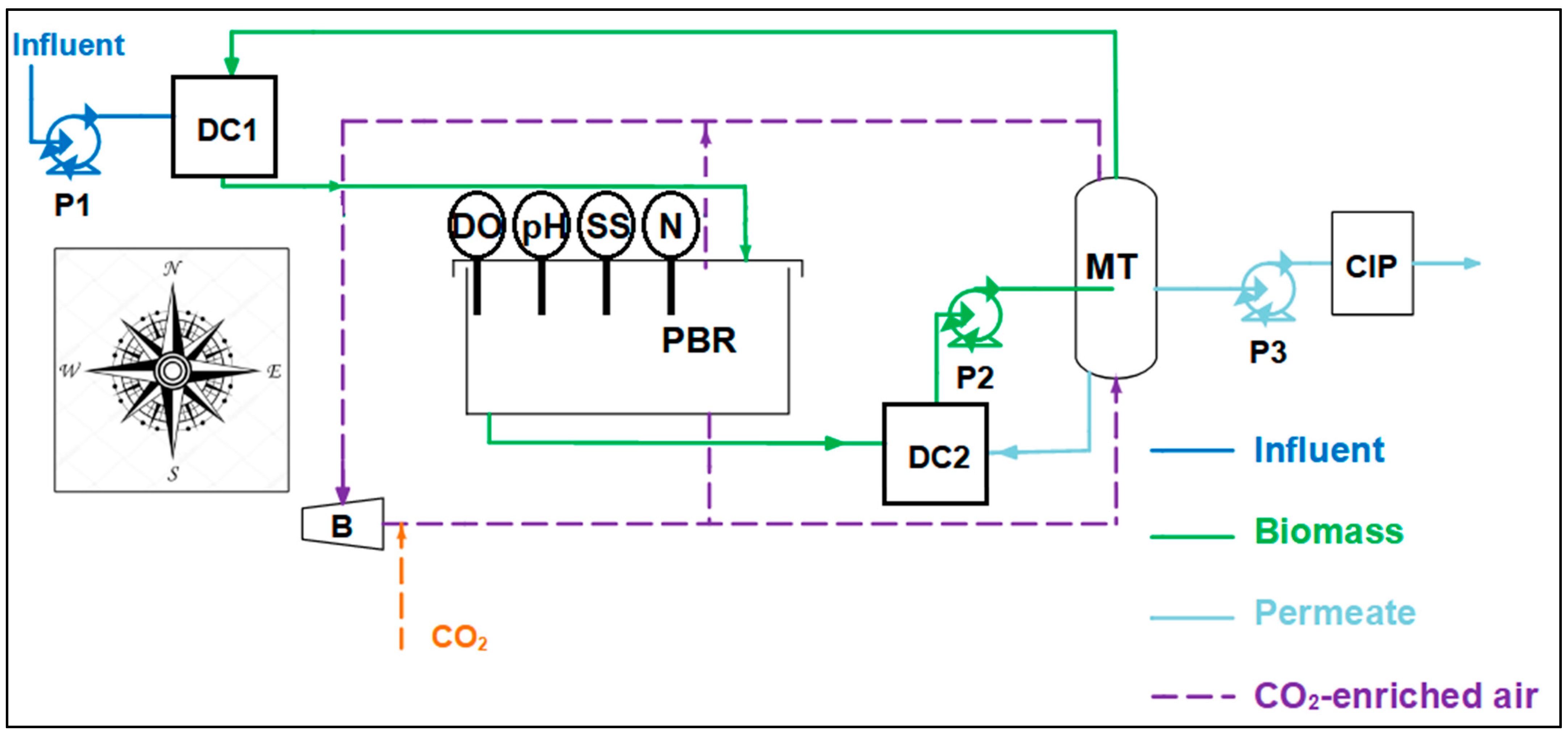
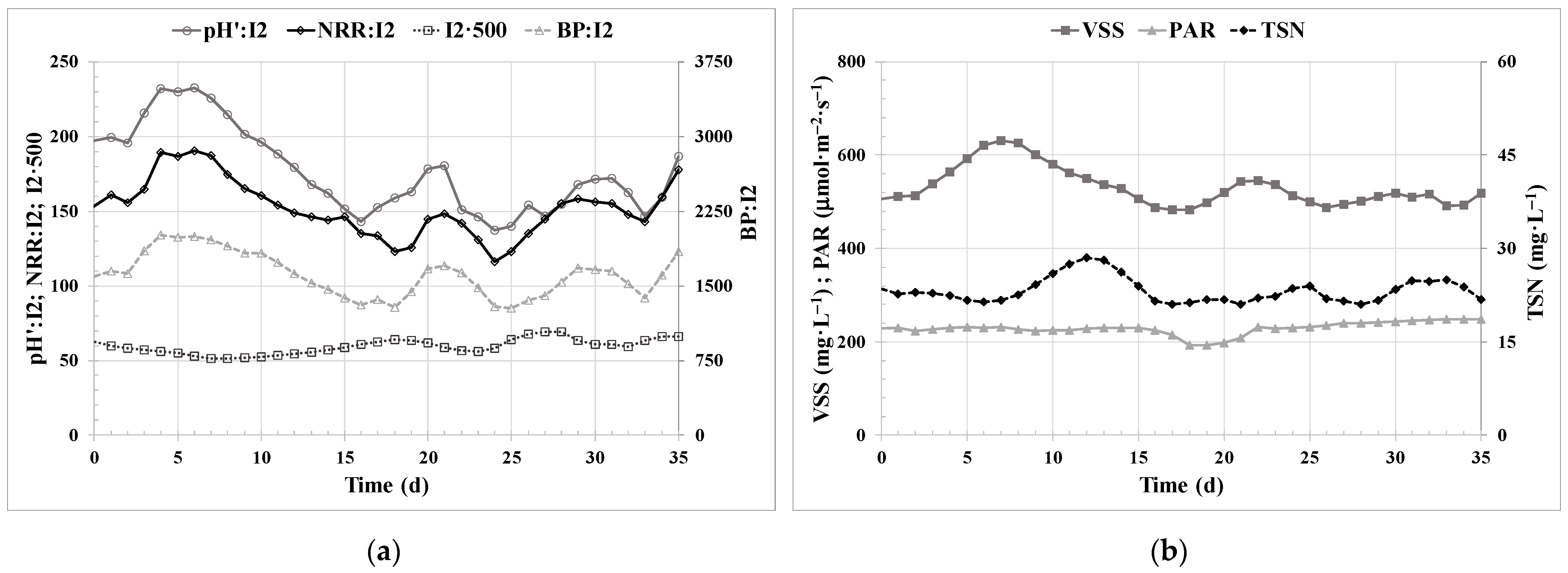

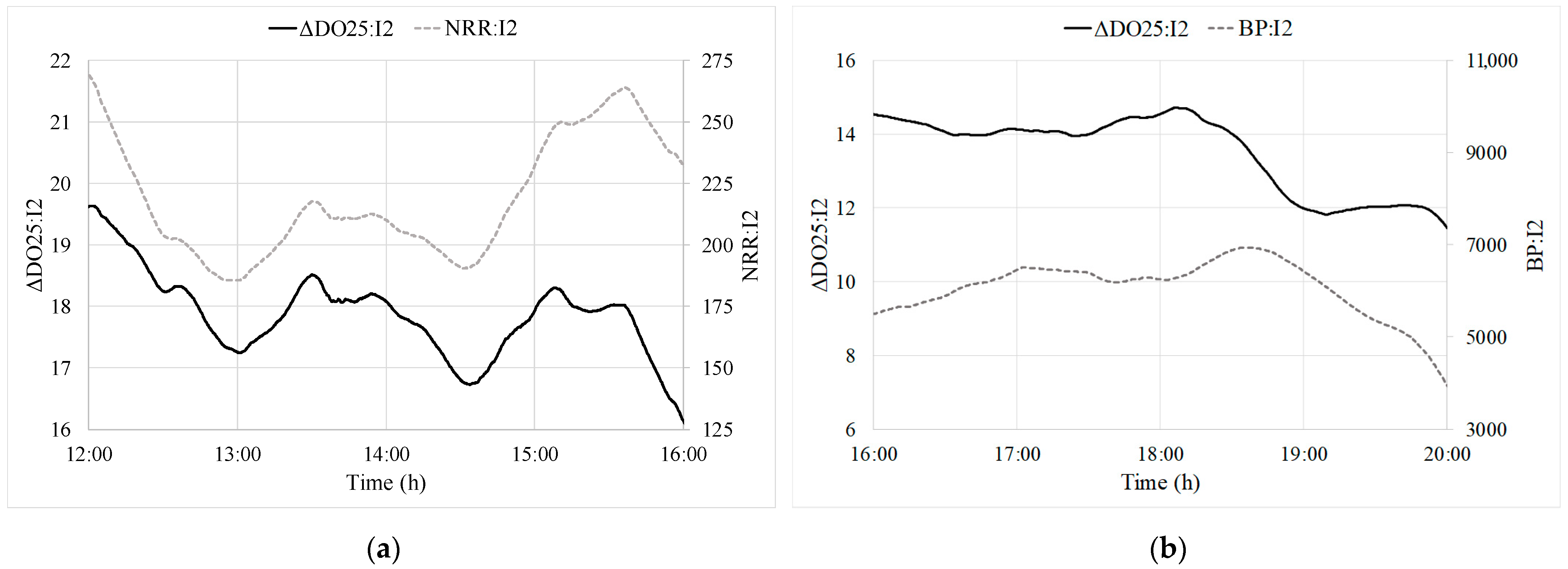
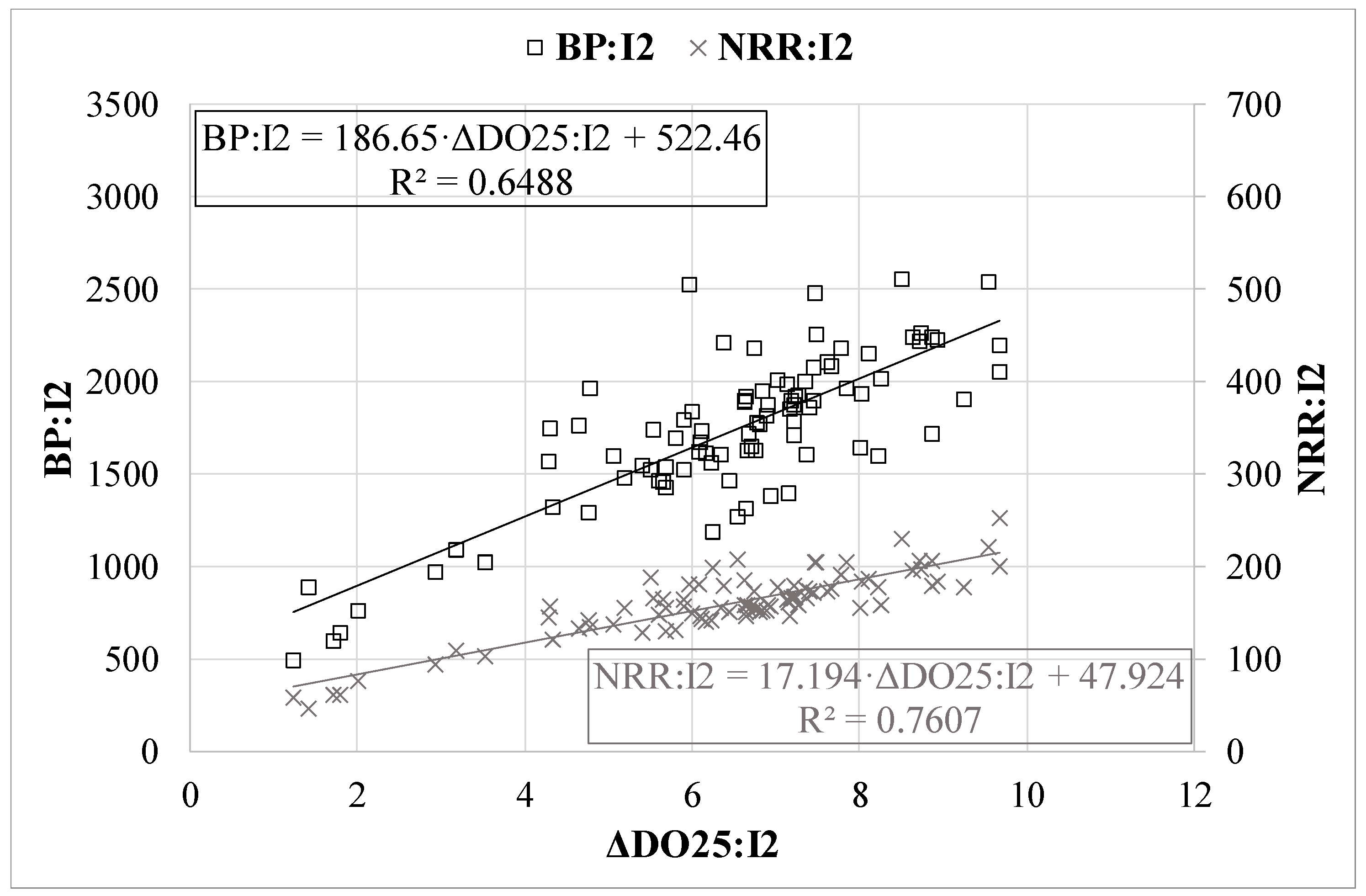
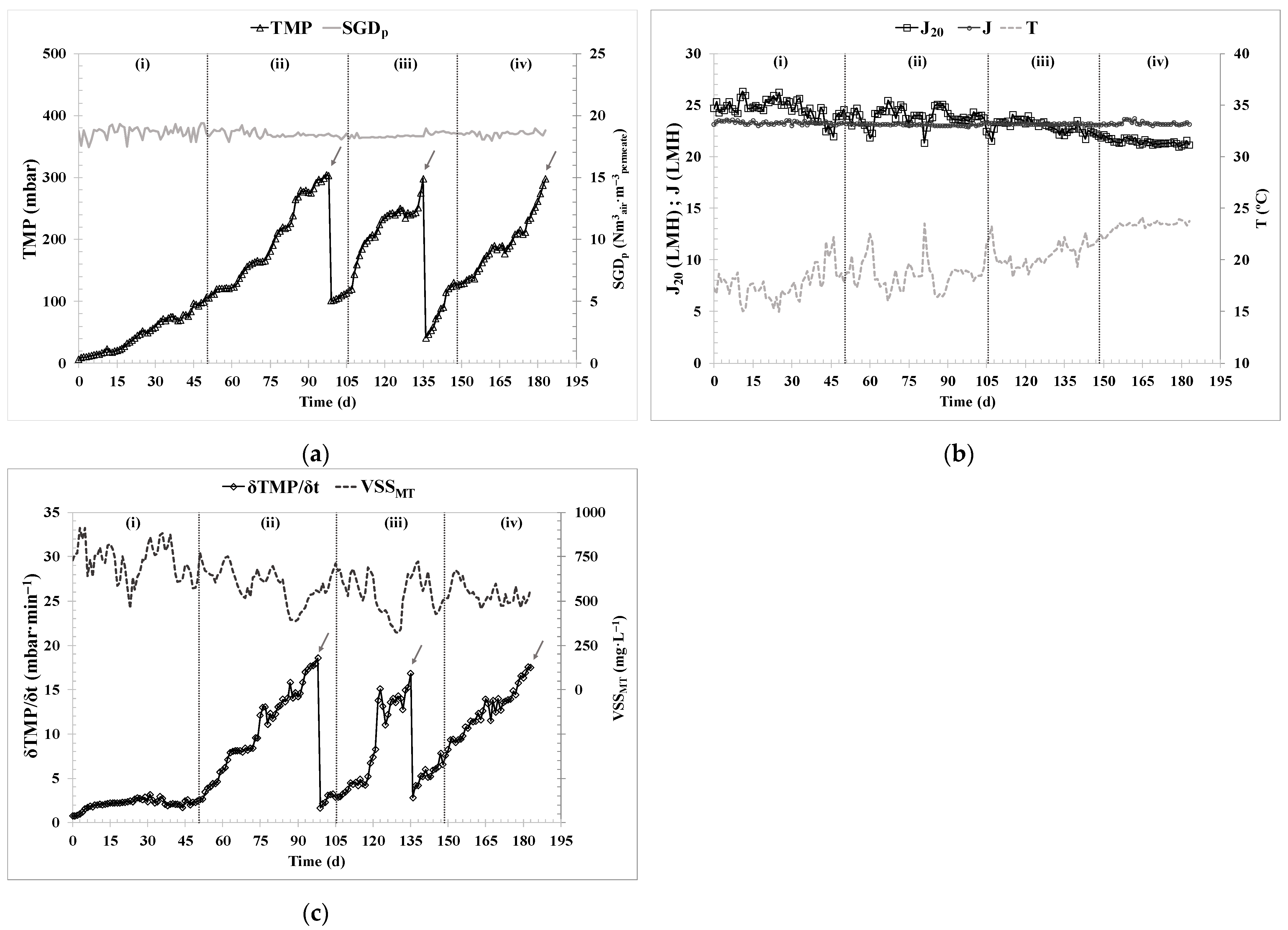

| Variable | Unit | Average ± Std Deviation |
|---|---|---|
| Ammonium | mg N L–1 | 54.8 ± 3.7 |
| Oxidised nitrogen | mg N L–1 | 0.4 ± 0.1 |
| Phosphorus | mg P L–1 | 5.9 ± 0.5 |
| Nitrogen:Phosphorus | molar ratio | 20.7 ± 2.3 |
| Variable | Unit | Average ± Standard Deviation |
|---|---|---|
| Solar photosynthetically active radiation | μmol m–2 s–1 | 230 ± 20 |
| Maximum solar photosynthetically active radiation | μmol m–2 s–1 | 849 ± 66 |
| Temperature | °C | 23.3 ± 0.5 |
| Liquid-phase oxygen content | mg O2 ·L–1 | 9.7 ± 0.1 |
| Hydraulic retention time | d | 1.50 ± 0.01 |
| Nitrogen loading rate | g N m–3·d–1 | 38 ± 3 |
| Inference Rules |
|---|
| Rule 1: IF ΔpH′MA:I2 is LN and ∑SRT is LP, THEN ΔSRT is LN |
| Rule 2: IF ΔpH′MA:I2 is LN and ∑SRT is ZE, THEN ΔSRT is SN |
| Rule 3: IF ΔpH′MA:I2 is LN and ∑SRT is SP, THEN ΔSRT is SN |
| Rule 4: IF ΔpH′MA:I2 is ZE, THEN ΔSRT is SN |
| Rule 5: IF ΔpH′MA:I2 is LP, THEN ΔSRT is ZE |
| Rule 6: IF ΔpH′MA:I2 is LN and ∑SRT is SN, THEN ΔSRT is SP |
| Rule 7: IF ΔpH′MA:I2 is LN and ∑SRT is LN, THEN ΔSRT is LP |
| Filtration Interval | Operation Interval (d) | MPBR Operating Mode | SRT (d) | HRT (d) | VSSMT (g·L–1) | T (°C) |
|---|---|---|---|---|---|---|
| (i) | 1–50 | Fixed-SRT&HRT | 2.25 ± 0.02 | 1.50 ± 0.01 | 0.79 ± 0.11 | 18 ± 2 |
| (ii) | 51–105 | Controlled HRT-Fixed SRT | 2.25 ± 0.01 | [1.02–2.25] | 0.64 ± 0.11 | 19 ± 2 |
| (iii) | 106–148 | Fixed-SRT&HRT | 3.45 ± 0.94 | 2.25 ± 0.02 | 0.06 ± 0.12 | 20 ± 1 |
| (iv) * | 149–183 | Controlled SRT-Fixed HRT | [2.30–3.00] | 1.50 ± 0.01 | 0.59 ± 0.06 | 23.3 ± 0.5 |
| Parameter | Unit | Mean ± SD |
|---|---|---|
| PBR VSS concentration | g·L–1 | 0.51 ± 0.04 |
| SRT | d | 2.59 ± 0.16 |
| NRR | g N·m–3·d–1 | 19 ± 5 |
| BP | g VSS·m–3·d–1 | 198 ± 56 |
| Study | Type of Operation | SRT (d) | HRT (d) | NRR:I:VSS (mgN·mol-photon–1·gVSS–1) | BP:I:NLR (gVSS·mol-photon–1·mgN–1) | Reference |
|---|---|---|---|---|---|---|
| 1 | Controlled SRT–Fixed HRT | [2.30, 3.00] | 1.50 | 0.80 | 0.113 | This study |
| 2 | Controlled HRT–Fixed SRT | 2.25 | [1.02, 2.25] | 0.62 | 0.116 | [28] |
| 3 | Fixed-SRT and HRT | 3.00 | 1.50 | 0.53 | 0.105 | [43] |
| Parameter | Unit | This Study | Period 1 Data from [43] |
|---|---|---|---|
| Effluent source | - | Aerobic | Anaerobic |
| Experimental span | d | 183 | 26 |
| MT VSS concentration | g·L–1 | 0.66 ± 0.13 | 0.80 ± 0.06 |
| J20 | LMH | 23 ± 2 | 26 |
| Fouling rate | mbar·min–1 | 7.7 ± 5.3 | 10–35 |
| SGDp | Nm3air·m–3permeate | 18.3 ± 0.4 | 16–20 |
| Maximum TMP | mbar | 300 | 500 |
| Chemical cleaning frequency | d | 61 | 13 |
Disclaimer/Publisher’s Note: The statements, opinions and data contained in all publications are solely those of the individual author(s) and contributor(s) and not of MDPI and/or the editor(s). MDPI and/or the editor(s) disclaim responsibility for any injury to people or property resulting from any ideas, methods, instructions or products referred to in the content. |
© 2023 by the authors. Licensee MDPI, Basel, Switzerland. This article is an open access article distributed under the terms and conditions of the Creative Commons Attribution (CC BY) license (https://creativecommons.org/licenses/by/4.0/).
Share and Cite
Mora-Sánchez, J.F.; Ribes, J.; González-Camejo, J.; Seco, A.; Ruano, M.V. Towards Optimisation of Microalgae Cultivation through Monitoring and Control in Membrane Photobioreactor Systems. Water 2024, 16, 155. https://doi.org/10.3390/w16010155
Mora-Sánchez JF, Ribes J, González-Camejo J, Seco A, Ruano MV. Towards Optimisation of Microalgae Cultivation through Monitoring and Control in Membrane Photobioreactor Systems. Water. 2024; 16(1):155. https://doi.org/10.3390/w16010155
Chicago/Turabian StyleMora-Sánchez, Juan Francisco, Josep Ribes, Josué González-Camejo, Aurora Seco, and María Victoria Ruano. 2024. "Towards Optimisation of Microalgae Cultivation through Monitoring and Control in Membrane Photobioreactor Systems" Water 16, no. 1: 155. https://doi.org/10.3390/w16010155
APA StyleMora-Sánchez, J. F., Ribes, J., González-Camejo, J., Seco, A., & Ruano, M. V. (2024). Towards Optimisation of Microalgae Cultivation through Monitoring and Control in Membrane Photobioreactor Systems. Water, 16(1), 155. https://doi.org/10.3390/w16010155








